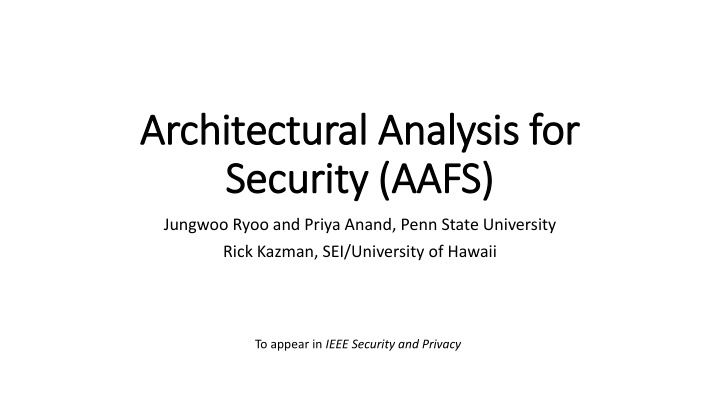



Ar Arch chitectu tural An Analysi sis f s for or Security ( y (AAF AAFS) S) Jungwoo Ryoo and Priya Anand, Penn State University Rick Kazman, SEI/University of Hawaii To appear in IEEE Security and Privacy
Arch chitectu ctural al Anal nalysi sis • Structured way of discovering Design decisions in software Present or Absent Quality attribute goals of stakeholders Security, Modifiability, Performance, Usability, Etc. 2
Significance of Architectural Analysis • During early design Recommended • During maintenance After the system is built A basis for refactoring Disruptive Costly Risky 3
Motivations and S Significance • Not too many Well established architectural analysis methods Example Architectural Tradeoff Analysis Method (ATAM) • Not to mention Architectural analysis method specializing in security • Dire need for Architectural Analysis for Security (AAFS) Security: Costly and risky dominant concern 4
Our Ap r Approach • The use of design constructs Helps reason about security • AAFS Contains Tactic-oriented Architectural Analysis (ToAA) Pattern-oriented Architectural Analysis (PoAA) Vulnerability-oriented Architectural Analysis (VoAA) Uses Interviews 5
Tactics • Design Technique To satisfy a single quality attribute requirement • Aha! moment Why not for architectural analysis ? • SATURN 2014 6
Secu curity T y Tac actics cs • Useful vocabulary Security Tactics During architectural design and analysis Recover Detect Attacks Resist Attacks React to from Attacks Attacks For security Identify Revoke Actors Detect Maintain Restore Access Intrustion Audit Trail Authenticate System detects, Attack Actors Detect Service Lock resists, reacts, Denial Computer or recovers Authorize See Verify Message Actors Availability • Intentionally abstract Inform Integrity Actors Limit Access Detect Message To establish a baseline Delay Limit Exposure Encrypt Data For further investigation Separate Entities Change Default Settings 7
Securi rity P Pattern rns • Well-known solutions to Recurring security problems • Refined and instantiated from Security tactics • Closer to code 8
Vulnerabilities • Software Weaknesses Exploitation by attackers Code level • Vulnerability databases Common Vulnerabilities and Exposures (CVE) Common Weakness Enumeration (CWE) • Relationship with architectural solutions Missing tactic or pattern 9
CVE vs. CWE • Security scenarios or test cases • CVE Individual incident reports More than 70,000 and still counting • CWE Categories of the incident report 940 entries 10
Our Ap r Approach P Provi vides a Holistic V View of Securi rity ty • The ultimate goal To identify The absence or presence of a design decision ToAA and PoAA The misinterpretation or violation of a design decision in the source code VoAA 11
Steps o of Our M r Methodology • Step 1 Tactic-oriented Architectural Analysis (ToAA) ToAA • Step 2 PoAA Pattern-oriented Architectural Analysis (PoAA) VoAA • Step 3 Vulnerability-oriented Architectural Analysis (VoAA) 12
Case Study • OpenEMR Electronic Medical Record (EMR) System Open Source Released in 2001 531,789 LOC Big user base • Factors in choosing a subject Access to architect and source code 13
To ToAA Phase • Interview an architect Where How • Identify design Rationale Assumptions 14
Po PoAA Ph Phase • Relate ToAA results to Patterns ‘ Verify message integrity ’ ToAA • Check tactic realization Intercepting Validator Verifies user inputs before they are used Performs filtering to all requests or user inputs According to validation rules Forwards full, partial, or no input to the target Depending on the validation results 15
Vo VoAA Phase • Relate PoAA results to CWE categories Ties the suspicion to a piece of code • CWE entries related to ‘ Verify message integrity ’ tactic ‘ Intercepting validator ’ pattern • CWE 89 : Improper neutralization of special elements used in an SQL command • CWE 87 : Improper neutralization of alternate XSS syntax 16
OpenEMR A Analysis S Sample Results ts • ToAA ‘ Verify message integrity ’ Partially supported by Standard library functions for sanitizing user inputs • PoAA No intercepting validator • VoAA CWE 89: Ad hoc and incomplete coverage CWE 87: No coverage 17
Verifi ficati tion • Vulnerability analysis by IBM AppScan OpenEMR 3.1.0 OpenEMR Scan Results 4.1.2 96 • SQL injection Improving but still problematic 65 61 • XSS 12 Highly problematic SQL INJECTION XSS 3.1.0 4.1.2 18
Future Research • More case studies Nuxeo • Tactic realization ontology • Mapping between patterns and CWE entries 19
Qu Ques estion ons? 20
Recommend
More recommend